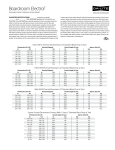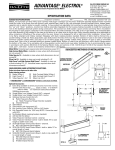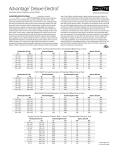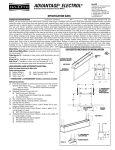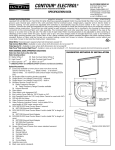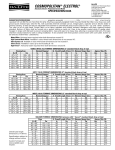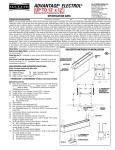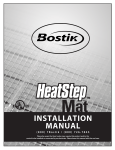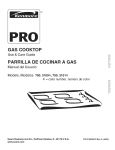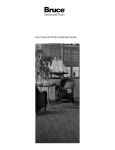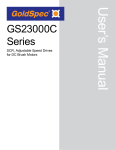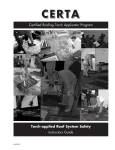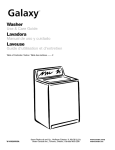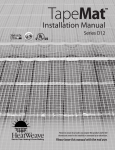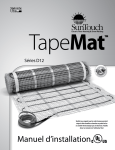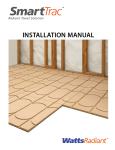Download INSTALLATION MANUAL
Transcript
Wire INSTALLATION MANUAL (800) 7Bostik / (800) 726-7845 Please be aware that local codes may require this product and/or the control to be installed or connected by an electrician. Please leave this manual with the end user. 2 HeatStep™ Wire Installation Manual Welcome to HeatStep™ Wire HeatStep™ Wire is a simple, economical way to warm any floor, and provide years of lasting comfort. This instruction manual provides complete details, suggestions, and safety precautions for installing this floor-warming system. Fasten the cables to the floor. Then, depending on the floor coverings to be used, put down a layer of thin-set, thick-set, or self-leveling mortar on top of the cables. Finally, install the floor coverings. It’s that simple! Table of Contents Phase 1: Design the System . . . . . . . . . . . . . . . . . . . . . . . . . . . 3 Phase 2: Preparation . . . . . . . . . . . . . . . . . . . . . . . . . . . . . . . . . . 4 Cautions . . . . . . . . . . . . . . . . . . . . . . . . . . . . . . . . . . . . . . . . . . . 4 Tips . . . . . . . . . . . . . . . . . . . . . . . . . . . . . . . . . . . . . . . . . . . . . . . . 5 Items Needed . . . . . . . . . . . . . . . . . . . . . . . . . . . . . . . . . . . . . . 5 Phase 3: Inspect the Cable and Sensor . . . . . . . . . . . . . . . 5 Cable and Sensor Resistance Log . . . . . . . . . . . . . . . . . . . 6 Phase 4: Electrical Rough-in . . . . . . . . . . . . . . . . . . . . . . . . . . 7 New Construction . . . . . . . . . . . . . . . . . . . . . . . . . . . . . . . . . . 7 Existing Construction . . . . . . . . . . . . . . . . . . . . . . . . . . . . . . 7 Phase 5: Install the Cable . . . . . . . . . . . . . . . . . . . . . . . . . . . . . 8 Getting Started . . . . . . . . . . . . . . . . . . . . . . . . . . . . . . . . . . . . 8 General Installation . . . . . . . . . . . . . . . . . . . . . . . . . . . . . . . . 9 Other Installations . . . . . . . . . . . . . . . . . . . . . . . . . . . . . . . 10 Final Steps . . . . . . . . . . . . . . . . . . . . . . . . . . . . . . . . . . . . . . . 11 Phase 6: Finish Wiring . . . . . . . . . . . . . . . . . . . . . . . . . . . . . . . . 12 New Construction . . . . . . . . . . . . . . . . . . . . . . . . . . . . . . . . 12 Existing Construction . . . . . . . . . . . . . . . . . . . . . . . . . . . . 12 Phase 7: Install the Control . . . . . . . . . . . . . . . . . . . . . . . . . . 13 Phase 8: Install the Floor Coverings . . . . . . . . . . . . . . . . . 13 Phase 9: Install Insulation . . . . . . . . . . . . . . . . . . . . . . . . . . . . 13 Phase 10: System Operation . . . . . . . . . . . . . . . . . . . . . . . . . 13 Appendix 1: Types of Construction . . . . . . . . . . . . . . . . 14 Appendix 2: Typical Electrical Wiring Diagrams . . . 16 Appendix 3: Connecting Multiple Cables . . . . . . . . . . 18 Appendix 4: Connecting the Wire Fault Detector . 19 Appendix 5: Sample Layouts . . . . . . . . . . . . . . . . . . . . . . . 20 Troubleshooting Guide . . . . . . . . . . . . . . . . . . . . . . . . . . . . . . 25 Installation Facts Skill level Installation must be performed by qualified persons, in accordance with local codes, ANSI/NFPA 70 (NEC Article 424) and CEC Part 1 Section 62 where applicable. Prior to installation please consult the local codes in order to understand what is acceptable. To the extent this information is not consistent with local codes, the local codes should be followed. However, electrical wiring is required from a circuit breaker or other electrical circuit to the control. It is recommended that an electrician perform these installation steps. Please be aware local codes may require this product and/or the control to be installed by an electrician. Expected floor temperature The floor temperature attainable is dependent on how well the floor is insulated, the temperature of the floor before start up, and in the case of uninsulated slab applications, the thermal drain of the underlying materials. These are the three most common installations: 1. Wood framing: With the cable installed on a well-insulated wood subfloor, and thin-set mortar and tile on top, most floors can be heated up to 20°F warmer than they would otherwise be. 2. Insulated concrete slab: With the cables installed on an insulated concrete slab, and thin-set mortar and tile on top, most floors can be heated up to perhaps 15°F warmer than they would otherwise be. 3. Uninsulated concrete slab: With the cables installed on an uninsulated concrete slab, and thin-set mortar and tile on top, most floors can be heated up to perhaps 10°–15°F warmer than they would otherwise be. Please consult a designer or the factory if questions remain about the surface temperature that can be expected from the cables in any particular construction. Please see “Phase 9: Install Insulation” on page 13. Specifications: HeatStep™ Wire is a complete heating cable consisting of a series resistance heating cable and single power lead for easy single-point connection. The heating cable cannot be cut to fit. Voltages: 120, 240 VAC, 1-phase Watts: 10 W/sqft (34 Btu/h/sqft) when spaced 3 inches on center, up to 15 W/sqft (51 Btu/h/sqft) when spaced 2 inches on center (see Table 1) Maximum heater current: 10 amps Maximum circuit load: 15 amps Maximum circuit protection: 20 amps breaker GFCI: (Ground Fault Circuit Interrupter) required for each circuit (included in the HeatStep™ control) Listing: UL Listed for U.S. and Canada under UL 1673 and CAN/CSA C22.2 No. 130.2-93, File No. E185866 Application: (-X) - (see UL Label on product) For indoor floor heating application only. Shower area Listed (see Step 5.20 for restrictions) (-W on the nameplate label indicates CUL Listing for Wet Location in Canada per Canadian Electrical Code, Part I (CEC). Embedded in polymer-modified cement based mortar only (see Appendix 1).Minimum bend radius: 1 inch Maximum exposure temperature: (continuous and storage) 194ºF (90ºC) Minimum installation temperature: 50ºF (10ºC) HeatStep™ Wire Installation Manual 3 STEP 1.1 2” spacing NEVER use less than 2” spacing. 2-1/2” spacing 3” spacing NEVER exceed 3” spacing. Kitchen Design Cabinets Sink Refrigerator 1. Heated area = total area – built-in areas. 2. Multiply heated area x 0.90 3. Select Appropriate product size Phase™ 1: Design the System HeatStep Wire should be installed in all interior floor areas that are to be warmed. It cannot be used for exterior applications, snow melting, or in ceilings. In some applications, it can be used to heat the room as well, but in general it is not designed for this purpose (heat-loss calculations must be made to determine if enough heat will be provided to match the heat loss of the room). STEP 1.1 Make a sketch of the room. Measure the total square footage of floor area to be warmed (measurements should be made all the way to the edge of walls, cabinets, tub, etc., for now). Keep in mind the following: • Heat will not radiate beyond about 1-1/2” on either side of the cable, therefore consistent coverage is important. • The cables can be installed in permanent bench seats with tile or stone coverings. • Cables only with (-W) on the nameplate label may be installed into shower floors and bench seats. However, do not install them into the walls. Consider installing a dedicated cable in the shower area separate from the rest of the bath floor. In case there is ever a problem with the shower installation, this cable could be disconnected without loss of heat to the rest of the floor. Acceptance of this shower application must be verified by the local inspector or authority having jurisdiction. See Step 5.20 and Appendix 5 for details and precautions. • Do install cable within about 1-1/2” to 2” from a counter or vanity in the kick-space to ensure warmth in this area. • Do not install the cables underneath cabinets or fixtures or inside a wall. Excessive heat will build up and cause damage. • Do not run the cables into small closets or other confined areas where excessive heat will build up. • Do not install the cables closer than 6” from toilet rings to avoid possible melting of wax rings. • Do not cross expansion joints. Install the heating wires 4” to 6” away from the perimeter walls of the room. This will help avoid locating heating wire underneath finish trim. STEP 1.2 Select the cable spacing. Below are typical spacings for various types of rooms. This spacing can vary depending on the insulation of the floor and room, and the desired effect. Never space cables closer than 2” apart; this will cause a very hot area and may cause damage. Typical uses: • 2” spacing: Sunroom floors, basement slabs, and baths with exterior walls. (NOTE: Insulation is always recommended due to high heat losses in these areas. Performance is never guaranteed due to construction and climate differences in these applications.) • 2-1/2” spacing: Bathrooms, kitchens, living areas, and basements. • 3” spacing: Hallways, entryways, and large areas with low heat loss. STEP 1.3 Multiply the square footage measured in Step 1.1 by 0.90 to allow for 3” spacing around the edges of the floor area. Use this resulting square footage to select the appropriate cable from the tables on page 4. Remember: • Do not place over 15 amps at 120 VAC (1800 watts) or 15 amps (3600 watts) at 240 VAC through a control. • Select either 120 VAC or 240 VAC depending on the power available. DO NOT mix voltages on the same system if more than one cable is to be installed to cover an area. • Load no more than 12 amps (1440 watts) on a 15-amp circuit breaker, or 16 amps (1920 watts) on a 20-amp circuit breaker. • If you have an area that requires more than 15 amps of cables to be controlled by one thermostat, use HeatStep™ Relay(s) to take the additional amp load. • See the Wiring Diagrams in Appendix 2 for help. If the exact size of cable calculated is not found in the spool selection tables on page 4, it may be necessary to adjust the warming area(s) or select the next smaller spool size. Remember, the cable must never be cut shorter to fit, and must be embedded completely in mortar in the floor. Be careful not to select a spool that is too large. STEP 1.4 Use the wire strap (included in wire kit) to secure the cable to the floor. One box contains 25 ft. of strap, enough to prepare about 50 sq. ft. of floor at 4-ft. spacing. Strap is usually spaced every 3 to 4 ft. Use of methods to secure the cable other than those described in this Manual voids the Warranty and are not allowed unless authorized by the manufacturer in writing. Do not use nails, staples, or similar. 4 HeatStep™ Wire Installation Manual Table 1 - Cable Sizes 240 VAC Spools Example. There are 270 sq. ft. of kitchen and dining area to be warmed with 240 VAC. The cable is to be spaced at 3” to provide 10 watts/sq. ft., providing warmth across the entire floor area. As seen in Table 1, choose Model Numbers K640212 and K640214 to end up with about 264 sq. ft. covered. Model Number Total Sq. ft. Total Sq. ft. Total Sq. ft. 2” Spacing 2-1/2” Spacing 3” Spacing 15 watts/sq. ft. 12 watts/sq. ft. 10 watts/sq. ft. Wire Length (ft.) Amperage Resistance Draw (ohms) K640210 648096376 4.0 51-63 K640212 80 100120470 5.0 41-51 K640214 96 120144564 6.0 34-42 K640216 112140168658 7.0 29-36 K640280 128160192752 8.0 25-32 Note: Other HeatStep™ Wire sizes avialable in both 120 VAC and 240 VAC upon request. NO! Phase 2: Preparation Table 2 - Cautions CAUTION! As with any electrical product, care should be taken to guard against the potential risks of fire, electric shock, and injury to persons. The following cautions must be observed: NEVER bang a trowel or other tool on the heating cable. ALWAYS! Always completely embed the factory splice and all heating wire in mortar. NEVER bend the splice or place any part of it in the wall or through the floor. NO! NEVER use 1” spacing NEVER use less than 2” spacing. NEVER install Heating wire under carpet, wood, vinyl, or other non-masonry flooring without embedding it in Bostik SL-150™, WebCrete® 95, WebCrete® 98 or Ultra Finish™. NEVER install HeatStep™ wire in adhesives or glues intended for vinyl tile or other laminate flooring, or in pre-mix mortars. It must be embedded in polymermodified, cement based mortar. NEVER cut the heating wire. Doing so will cause dangerous overheating and will void the warranty. The power lead may be cut shorter if necessary, but never remove completely from the heating wire. NEVER bang a trowel or other tool on the heating wire. Be careful not to nick, cut, or pinch the wire causing it to be damaged. NEVER use nails, staples, or similar to fasten the heating wire to the floor. NEVER attempt to repair a damaged heating wire, splice, or power lead using unauthorized parts. Use only factory authorized repair parts and methods. NEVER splice one heating wire to another to make it longer. Multiple heating wire power leads must be connected in parallel in a junction box or to the thermostat. NEVER install one heating wire on top of another or overlap the heating wire on itself. This will cause dangerous overheating. NEVER forget to install the floor sensor included with the thermostat. NEVER install HeatStep™ wire in any walls, or over walls or partitions that extend to the ceiling. NEVER install heating wire under cabinets or other built-ins having no floor clearance, or in small closets. Excessive heat will build up in these confined spaces, and the heating wire can be damaged by fasteners (nails, screws, etc.) used to install built-ins. NEVER remove the nameplate label from the power leads. Make sure it is viewable for inspection later. NEVER extend the heating wire beyond the room or area in which it originates. NEVER allow a power lead or sensor wire to cross over or under a heating cable. Damage could result. ALWAYS completely embed the heating wire and factory splices in Bostik SL-150™, WebCrete® 95, WebCrete® 98 or Ultra Finish™. ALWAYS maintain a minimum of 2” spacing between heating wires. ALWAYS pay close attention to voltage and amperage requirements of the breaker, the thermostat, and the HeatStep™ wire. For instance, do not supply 240 VAC power to 120 VAC HeatStep™ wire as damage will result. ALWAYS make sure all electrical work is done by qualified persons in accordance with local building and electrical codes, Section 62 of the Canadian Electrical Code (CEC) Part I, and the National Electrical Code (NEC), especially Article 424. ALWAYS use copper only as supply conductors to the thermostat. Do not use aluminum. ALWAYS seek help if a problem arises. If ever in doubt about the correct installation procedure to follow, or if the product appears to be damaged, the factory must be called before proceeding with the installation. HeatStep™ Wire Installation Manual 5 ALWAYS Some Tips Trowel. Use a plastic trowel to reduce the possibility of cable damage. Insulation. The better insulation that is provided, the more efficiently the system operates, and the better the floor is heated. Concrete slab surfaces offer the most thermal drain and should be insulated before applying the cables, if at all possible. See “Phase 9: Install Insulation” as well as the cross sections in Appendix 1. Controls. The HeatStep™ controls will provide direct floor-warming control for better comfort. Other controls are not approved for use with HeatStep™ Cables. Mortars. Self-leveling mortars are becoming more popular to use because of their ease of application over the cables. If laying tile, another layer of thin-set will need to be applied in order to lay the tile. Always use polymer-modified cement-based mortar. Do not use solvent-based adhesives or pre-mixes because they are not as heat resistant. Wire Fault Detector. The Wire Fault Detector sounds an alarm if damage occurs to the cable during installation. The Detector stays connected to the power leads throughout cable and tile installation. A small screwdriver for connecting the leads is included with the Wire fault detector. Items Needed STEP 3.1 Materials: • HeatStep™ system • HeatStep™ Wire Strap (provided with cable) • Thermostat control with floor sensor • 20-amp circuit breaker (single for 120-VAC and dual for 240-VAC systems) • Electrical box (extra deep) for the control; single-gang (not a gangable type) or 4”-square deep box with a single-gang “mud ring” cover • 4” junction box with a cover, if needed • Cable clamps for junction box (for new construction) • Flexible or rigid conduit (for new construction) • 12-gauge or 14-gauge electrical wiring cable (consult local code) • Wire nuts if using a junction box • Nail plate • Polymer-modified cement based mortar Tools: • Digital multi-meter [for ohms testing; must read up to 20,000 ohms (Ω) to measure sensor] • Drill with 1/2” bit • Hammer and chisel • Wire strippers • Phillips screwdriver • Fish tape (for existing construction) • Hole saw (for existing construction) • Trowel (plastic preferred) with 3/8” notches (or greater) Phase 3: Inspect the Cable and Sensor W ARNING: To prevent the risk of personal injury and/or death, make sure power is not applied to the product until it is fully installed and ready for final testing. All work must be done with power turned off to the circuit being worked on. STEP 3.1 Take the cable out of the box and inspect it to make sure there is no visible damage. Verify everything is the correct size and type according to the plan and the order. Do not attempt to install a damaged product. STEP 3.2 Record the product information. There is a factory-applied nameplate label on the power leads. Do not remove this label. Record the cable serial number, model number, voltage, and cable resistance range in the Cable and Sensor Resistance Log (Table 4). If installing more than one cable, do this for each of them. 6 HeatStep™ Wire Installation Manual Ground Lead White or Blue Lead Black Lead Black wire to COM Red wire to Ω STEP 3.3 Use a digital multi-meter set to the 200Ω or 2000Ω (2kΩ) range to measure the resistance between the black and white wires of the cable power leads (or black and blue wires for 240 VAC). Record these resistances in Table 4 under “Out of the box before installation”. The resistance should measure within the resistance range on the nameplate label. If it is a little high or low, it may be due to air temperatures or meter calibration. Consult the factory if in doubt. Measure the resistance between either of the white or black leads and ground lead. This measurement should be “open”, usually indicated by an “OL” or a “I”. This is the same as displayed when the test leads are not touching anything. 200 ohm setting Ground Lead IMPORTANT! To retain the Limited Warranty, the following measurements must be recorded, and all steps of this manual followed. White or Blue Lead Black Lead If there is any change in the reading, record this information and contact the factory before continuing. This could indicate damage, test lead problems, or a number of other issues. Try “pinning” the test leads to the cable lead wires against a hard non-metal surface if the readings continue to fluctuate. Change the meter to the 20,000 ohms (20 kΩ) range. Measure between the lead wires of the HeatStep™ Control sensor. This resistance varies according to the temperature sensed. Table 3 provides approximate resistance-totemperature values for reference. Ground Lead White or Blue Lead Black Lead Press the test lead tips to the Black and White (or Blue for 240 VAC) power lead wires. This reading should correspond to the factory resistance range on the name- plate label attached to the Power lead. Readings between the Black and Ground and the White (or Blue for 240 VAC) and Ground power lead wires should measure “open”, or “O.L”, or the same as displayed when the test leads are not touching anything. Table 3:: Floor Sensor Resistance Values Temperature Typical Values 55°F (13°C) 17,000 ohms 65°F (18°C) 13,000 ohms 75°F (24°C) 10,000 ohms 85°F (29°C) 8,000 ohms Table 4: Cable and Sensor Resistance Log CABLE 1 Cable serial number Cable model Cable voltage Factory cable resistance range OUT OF THE BOX BEFORE INSTALLATION (ohms) Cable black to white (black to blue for 240VAC) Cable black to ground Cable white to ground (blue to ground for 240VAC) Sensor wire AFTER CABLE AND SENSOR ARE FASTENED TO FLOOR (ohms) Cable black to white (black to blue for 240VAC) Cable black to ground Cable white to ground (blue to ground for 240VAC) Sensor wire AFTER FLOOR COVERINGS ARE INSTALLED (ohms) Cable black to white (black to blue for 240VAC) Cable black to ground Cable white to ground (blue to ground for 240VAC) Sensor wire RETAIN THIS LOG TO RETAIN THE WARRANTY! DO NOT DISCARD! CABLE 2 CABLE 3 HeatStep™ Wire Installation Manual 7 STEP 4.2 Phase 4: Electrical Rough-in See wiring diagrams in Appendix 2 for different voltages and applications. For additional help contact Bostik at 1-800-726-7845. New Construction (see below for existing construction) OVERVIEW We recommend the floor-warming system be installed on a dedicated circuit coming directly from the circuit breaker panel. Follow all National Electric Code (NEC), Canadian Electrical Code (CEC), and other local electrical code requirements when installing this system. Work should be done with great care and with the power turned off to the circuit being worked on. STEP 4.1 Install a maximum 20-amp circuit breaker(s) into the breaker panel, depending on the load of the system. Use a 120-VAC single-pole breaker for a 120-VAC system. Use a 240-VAC double-pole breaker for a 240-VAC system. For systems that are too large to directly power through one control but must be operated by one floor-sensing control, use a HeatStep™ control in combination with up to 10 HeatStep™ Relay Controls. Contact a HeatStep™ Install an extra-deep single-gang dealer or the factory for more information. box if connecting one or two cables to the control. Use a 4”-square deep STEP 4.2 Install an electrical box for the control. If installing one to two box with a single-gang mud ring cables, use an extra-deep single-gang box to allow plenty of room for the cover if connecting three cables, wiring. Use a 4”-square box if installing three cables. The box can be locatbecause the extra room is needed ed almost anywhere that is well ventilated. However, the best place is in for the wire, wire nuts, and control. the same room as the cable, typically about 60” above the floor, and within reach of the power lead wires of the cable. If installing more than three cables, it will be necessary to connect their power leads in a junction box first (see Step 4.4) to keep from overfilling the control electrical box. Then route one power supply from this junction box to the control box. See Step 5.22 for special requirements if the control will connect to a heating cable entering a shower area. STEP 4.3 Following code, feed 14- or 12-gauge NM type electrical wiring from the circuit breaker panel to the control electrical box. Leave about 6”–8” of extra wire extended from the box to work with. STEP 4.4 If the control box must be mounted in a location that is too far to reach with the power lead wires, it will be necessary to mount a junction box where the lead wires can be terminated. Use a standard junction box with a cover, mounting it below the floor, in the attic, or in another easily accessible location. It must remain easily accessible and not located behind a wall, cabinet, or similar obstruction. Then use 14- or 12-gauge NM type or other accepted electrical wiring to connect from the junction box to the control box. STEP 4.5 STEP 4.5 Drill two 1/2” holes in the baseplate directly below the control electrical box. Then, as close to the floor surface as possible, drill two horizontal holes, intersecting the top holes. STEP 4.6 If conduit is required by local electrical code, cut a length of 1/2” to 3/4” electrical conduit to run from the control box down to the baseplate. At the baseplate it may be necessary to chisel out more of the wood to make it easier to feed the wires up through the conduit. STEP 4.7 Mark the circuit breaker in the panel which feeds the system with “Floor warming/bath” or similar description. Existing Construction OVERVIEW It is recommended that the system be installed on a separate, dedicated circuit coming directly from the breaker panel. In existing construction, however, it may be difficult to do this depending on the location of wiring and the breaker panel. Tapping off an existing circuit may be possible, but only if there is enough load capacity to handle both the system and any additional loads that may be placed on the circuit. Keep in mind that typical hair dryers can pull up to 10 amps (1200 watts) of load. Follow all NEC, CEC, and other local electrical code requirements when installing this system. Work should be done with great care and with the power turned off to the circuit being worked on. 8 HeatStep™ Wire Installation Manual STEP 4.9 STEP 4.10 STEP 4.8 Install a maximum 20-amp circuit breaker(s) into the breaker panel, depending on the load of the system. Use a 120-VAC single-pole breaker for a 120-VAC system. Use a 240-VAC double-pole breaker for a 240-VAC system. For systems that are too large to directly power through one HeatStep™ Control but must be operated by one floor-sensing control, use a HeatStep™ Control in combination with up to 10 HeatStep™ Relay Controls. Contact a HeatStep™ dealer or the factory for more information. STEP 4.9 Cut an opening in the wall for the control electrical box. If installing one to two cables, use an extra-deep single-gang box to allow plenty of room for the wiring. Use a 4”-square box if installing three cables. The box can be located almost anywhere that is well ventilated. However, the best place is in the same room as the cable, typically about 60” above the floor, and within reach of the power lead wires of the cable. If installing more than three cables, it will be necessary to connect their power leads in a junction box first (see Step 4.11) to keep from overfilling the control box. Then route one power supply from this junction box to the control box. See Step 5.22 for special requirements if the control will connect to a heating cable entering a shower area. STEP 4.10 Following code, feed 14- or 12-gauge NM type electrical wiring from the circuit breaker panel to the control electrical box opening. Leave about 6”–8” of extra wire extended from the opening. STEP 4.11 If the control box must be mounted in a location that is too far to reach with the power lead wires, it will also be necessary to mount a junction box where the lead wires can terminate. Use a standard junction box with a cover, mounting it below the floor, in the attic, or in another easily accessible location. It must remain easily accessible and not located behind a cabinet or similar obstruction. Then use 14- or 12-gauge NM type or other accepted electrical wiring to connect from the junction box to the control electrical box. STEP 4.11 STEP 4.12 At the floor level below the control box, cut a 2”x 2”-wide piece from the wall surface. Use a wood chisel to notch out a channel in the baseplate to make it easier to route the wires up the wall. STEP 4.13 Mark the circuit breaker in the panel which feeds the system with “Floor warming/bath” or similar. Phase 5: Install the Cables Getting Started STEP 4.12 IMPORTANT! Refer to Phase 8 and Appendix 1 to make sure the floor is properly prepared for installation of the cable(s), especially the use of reinforcement, leveling, and insulation on concrete slab. STEP 5.1 Use the sketch and design considerations made earlier in Phase 1 to begin laying the cables. Do not install the cables closer than about 6” from wax toilet rings and plumbing to keep from overheating these items. STEP 5.2 Make sure to space the cables to provide the warmth desired. WARNING This heating cable CANNOT be cut shorter to fit! Do not overlap or cross over heating cable on itself. Do not space heating cables less than 2” apart. Failure to do so may result in damage to the product and dangerous overheating. STEP 5.3 STEP 5.3 If this is new construction, draw lines on the floor or use templates to outline the area of any cabinets, fixtures, or future walls that will be placed in the room. NEVER install the cables under cabinets, fixtures, or walls. Excess heat may build up under these items and cause damage. STEP 5.4 Decide which direction the cables will run on the floor for the easiest coverage. Refer to the sample layouts in this manual for assistance. Depending on the shape of the area, it may help to think of it in terms of several smaller areas. NO! NEVER use less than 2” spacing. HeatStep™ Wire Installation Manual 9 STEP 5.5 General Installation STEP 5.5 Measure about 3” from the wall for the strap. In counter or vanity kick-spaces, install the strap so the cable will be 1-1/2” to 2” away from the vanity base. STEP 5.6 Cut the strap to fit the length of the first area. STEP 5.6 STEP 5.7 STEP 5.7 Secure the strap to the floor. Depending on the floor type, different methods may be used. Refer to the instructions provided with the strap for full details. · Plywood, cement board, or similar: Galvanized nails or screws may be used to secure the strap every 6” to 10”. · Concrete or similar: Concrete nails or similar. Double-sided tape (if STEP 5.8 included with your cable), hot glue, or strong spray adhesive may be used if the floor is well cleaned and the strap is wiped free of any oils. However, it is highly recommended to also screw the strap down in several places to ensure it does not come loose. If using a strong spray adhesive, apply to both the back of the strap and the floor where it will be placed, and carefully follow all spray manufacturer’s instructions and cautions. STEP 5.8 Cut another piece of strap for the other end of the area and secure 3” from the wall(s) or other obstruction(s). STEP 5.9 Unreel the power leads of the cable up to the factory splice. Let the coil of power leads sit on the floor for now. Beyond the factory splice is the heating cable itself. Factory splice must be installed in the mortar bed. CAUTION: Completely embed the factory splices and heating cable in the mortar, and never bend the factory splices. NEVER allow any part of the splice or heating cable to enter a wall or drop through the subfloor. STEP 5.10 Before installing more strap, fill in the first section with cable. Begin by making a “strain-relief” at the beginning so the cable is not accidentally pulled loose. Zigzag the cable under the tabs only as shown. Press the tabs down to secure the cable. STEP 5.11 Weave the cable back and forth across the area at the desired spacing until the other side of the room has been reached. Once this area is completed, press down all the tabs. NEVER space the cables less than 2” apart. STEP 5.12 If there are additional areas to cover with cable, cut the lengths of strap necessary, attach them to the floor, and begin weaving the cable into that area. STEP 5.9 STEP 5.10 STEP 5.11 10 HeatStep™ Wire Installation Manual STEP 5.13 Other Installations STEP 5.14 Because many different room shapes and floor obstructions may be encountered in any given installation, additional layouts are provided below to assist in determining the best way to complete installations in oddshaped areas. Corner shower or vanity STEP 5.13 For an angled area, such as a corner shower, first cut several pieces of strap a little longer than the cable spacing being used. STEP 5.15 STEP 5.14 Use a chalk line or pen to mark the floor at 3” from the edge of the shower. STEP 5.15 Use this chalk line to attach each piece of strap to the floor so that the cable does not get any closer to the corner shower than 3”. Make sure that the cables are spaced evenly and parallel to one another. STEP 5.16 STEP 5.16 Fill in the section with cable. STEP 5.17 Door entryway STEP 5.17 For an entryway or other small area where warmth is required, begin by cutting two lengths of strap a little shorter than the length of the entry opening. Then secure the two straps parallel to each other. STEP 5.18 Fill in with cable, adjusting spacing as necessary to fill in as much of the area as possible. Bench Seat STEP 5.19 If covering a bench seat or step area (not in a shower area), place a single run up the riser. Use straps to secure the cable to the seat area at the desired spacing, then install a single run down the riser. Again, the cable on the riser and seat area MUST be fully embedded in mortar and have approved floor coverings. Use hot glue where necessary to secure the cable flat against the riser. STEP 5.18 Shower area installation This application into a shower area must be verified by the local inspector or the authority having jurisdiction. STEP 5.20 Cables only with (-W) on the nameplate label may be installed into a floor or bench seat located in a shower area. It must never be installed into walls. In general, the cable should be completely embedded into mortar directly below the surface coverings of tile or stone. Other types of coverings are not recommended. It may be installed into a mortar layer lower than this and beneath the waterproof system, however performance will be reduced. See Appendix 5 for an example of this type installation. Consider installing a dedicated cable in the shower area separate from the rest of the bath floor. In case there is ever a problem with the shower installation, this cable could be disconnected without loss of heat to the rest of the floor. STEP 5.21 Make sure the power lead factory splice (the connection between the power leads and the heating cable) is located outside the shower area and at least 1’ away from shower openings and other similar areas normally exposed to water. Make sure the control is located at least 4’ away from shower openings such that it cannot be exposed to water or touched by a person in the shower area. STEP 5.22 If the heating cable must enter the shower area over a curb, notch the corners of the curb with a minimum 1” wide notch to ensure the cable is not bent sharply or pinched when surface coverings are HeatStep™ Wire Installation Manual 11 installed. Do not damage any waterproofing components, and do not run the heating cable through a non-masonry curb, causing it to overheat. STEP 5.23 If covering a shower floor, cut lengths of strap and secure to the floor with adhesives. Do not use fasteners that penetrate any waterproofing membrane or waterproofing system. Fill in the floor area with cable. Around the drain leave at least 2” spacing from the edge of the flange. Make sure cable is not placed where door hardware, handrails, or other items may mount to the floor. STEP 5.24 If covering a bench seat in the shower, cut lengths of strap and secure to the top surface of the seat with adhesives. Do not use fasteners that penetrate any waterproofing membrane or waterproofing system. Use hot glue to secure a single run of cable up the side of the bench riser. Fill in the seat area with cable. Then secure a single run of cable down the riser if needed. STEP 5.25 If the cable cannot exit the shower area, the end of the cable has a waterproof splice that may be located in the shower area, fully embedded into the mortar like the heating cable. STEP 5.26 If any part of the heating cable entering a shower area is damaged during installation, do not attempt to repair it. A field repair or modification of the cable may result in serious shock hazard. HeatStep™ Control Factory Splice Thermostat Sensor Wire Strap Thin Set Mortar Tile/Stone HeatStep™ Wire cables only with (-W) on the nameplate label installed in shower floors and/or benches. See Step 5.20 and Appendix 5. Final Steps STEP 5.27 If a second cable is to be installed in the area, all power leads must come back to the control, or to a junction box and then to the control. NEVER run power leads across heating cables, under baseboard areas, or other potentially damaging areas. Never join two cables in series. STEP 5.28 To secure long lengths of heating cable, place additional, short lengths of the strap at 3–4-ft. intervals. Spray the back of the strap with a high-tack adhesive, and slide the strap, upside down, under the cables. Turn the strap over when it is positioned and adhere to the floor. Press the tabs down over the cables. If a spray adhesive was not used, carefully secure these short lengths of strap to the floor without damaging the cable. STEP 5.29 After the cable installation is completed, inspect the work. Make sure all tabs are pressed down, cable spacings are correct, no cables cross over each other, all the cables are undamaged, and all areas to be heated are covered with cable. STEP 5.30 Take resistance readings of the cable again to make sure it has not been damaged during the installation. This is very important to do. Record these readings in the Cable and Sensor Resistance Log (Table 4). STEP 5.31 (optional) With the heating portion of the cable fully installed, it is recommended that the cable be temporarily connected to the power source and allowed to heat for several minutes. After the cables begin to feel warm to the touch, disconnect the power. STEP 5.32 Lay cardboard, carpet, or similar material over the cables to protect them from damage until the floor covering is installed. 12 HeatStep™ Wire Installation Manual STEP 6.1 Phase 6: Finish Wiring STEP 6.1 Chisel a channel into the floor to lay the factory splice into. This will ensure the splice does not create a high-spot in the floor. CAUTION: The power lead splice MUST BE FULLY EMBEDDED IN the mortar bed and never bend the factory splices. NEVER allow any part of the splice or heating cable to enter a wall or drop through the subfloor. New Construction STEP 6.2 Feed the power leads from the cable up through the hole drilled in the baseplate, or up into the conduit to the control electrical box (or junction box if one was used). STEP 6.3 STEP 6.3 Secure the power lead splice into the chiseled channels with hot-glue. STEP 6.4 Below the control, or wherever the floor sensor is to be located, measure at least 1 ft. into the heated area. Mark the spot where the sensor will be attached to the floor. Be sure to locate the sensor exactly between two of the heating cables. STEP 6.5 To make sure the sensor tip does not create a high spot in the floor, chisel a channel into the floor and lay the sensor tip into the channel. Hot glue the tip into place. STEP 6.5 STEP 6.8 STEP 6.6 Drill another hole into the baseplate, if needed, to feed the sensor wire up to the control box. Finish by securing a steel nail plate over the wires to protect them against baseboard nails later. STEP 6.7 If it was necessary to end a power lead at a junction box, feed 14- or 12-gauge electrical wire from this box to the control box. Tip: If more than one cable was installed, label the ends of the power leads with a brief description as to which area they supply power. Use tape to label them “Cable 1,” “Cable 2,” “Kitchen,” “Bath,” or similar. This will make it easier to identify the leads later on. Take photos of the installation. This will provide a useful record for any future needs. STEP 6.4 STEP 6.6 Existing Construction STEP 6.8 Use a fish tape to pull the power leads up the wall to the control electrical box (or junction box if one was used). STEP 6.9 Secure the power lead factory splice into the chisled channel with hot-glue (see photo for Step 6.3). STEP 6.11 STEP 6.10 Below the control, or wherever the floor sensor is to be located, measure at least 1 ft. into the heated area. Mark the spot where the sensor will be attached to the floor. Be sure to locate the sensor exactly between two of the heating cables (see photo Step 6.4). To make sure the sensor tip does not create a high spot in the floor, chisel a channel into the floor and lay the sensor tip into the channel. Hot glue the tip into place (see photo Step 6.5). STEP 6.11 Use a fish tape to pull the sensor up the wall to the control electrical box, and finish by securing a steel nail plate over the power leads and sensor wires to protect them against baseboard nails. STEP 6.12 If it was necessary to end a power lead at a junction box, feed 14- or 12-gauge electrical wire from this box to the control box. Tip: If more than one cable was installed, label the power leads with a brief description as to which area they supply power. Use tape to label them “Cable 1,” “Cable 2,” or “Kitchen,” “Bath,” or similar. This will make it easier to identify the leads later on. Take photos of the installation. This will provide a useful record for any future needs. HeatStep™ Wire Installation Manual 13 Phase 7: Install the Control STEP 7.1 Read and follow the instructions that come with the HeatStep™ controls. STEP 7.3 STEP 7.2 Refer to the wiring diagrams in this manual for different voltages and applications. STEP 7.3 Install the electrical box for the control, if this has not already been done. Connect the power leads from the cable (or the electrical wiring coming from junction boxes) to the “LOAD” side of the control. Connect the incoming power to the “LINE” side of the control. Connect the sensor wires to the sensor terminals on the control. Connect the ground leads from the system to the ground wire from the incoming power. STEP 7.4 Install the control into its electrical box and turn the circuit breaker on to power the system. Test the system and control for several cycles. It should allow the heating cables to heat up correctly. Note: Consider placing a loose tile over the sensor tip to simulate warming the floor and allow the sensor to register this on the control. STEP 7.5 Retain all instruction sheets and warranties. Phase 8: Install the Floor Coverings STEP 8.1 Make a Final Inspection of the Installation. Inspect the installation very carefully for evidence of damage or missing sensor(s). STEP 8.2 Select Type of Construction. Choose the best thinset, thick-set, or self-leveling mortar method for the application. See Appendix 1 for reference. It is recommended to consult with professional flooring installers to make sure proper materials are used and proper installation techniques are followed. Please note, this installation manual is not a structural or a floor covering installation manual and is intended only for general guidance as it applies to the HeatStep™ Wire product. When installing tile or stone, the Tile Council of North America (TCNA) guidelines or ANSI specifications should be followed as a minimum standard. Use Bostik SL-150TM, WebCrete® 95, WebCrete® 98 or Ultra FinishTM. Do not use water-based multi-purpose materials when installing a radiant product. Do not use solvent based adhesives or pre-mix mortars because they are not as heat resistant and do not conduct heat well. Select the proper size trowel for the installation of tile or stone. We recommend a minimum 3/8” x 1/4” trowel. This trowel works well for most ceramic tile. A thicker thin-set can be used if required. Select the thin-set thickness in accordance with the floor covering requirements. For additional information on tile installation, please contact TCNA at 864-646-8453 or visit their web site at www. tileusa.com, or contact NTCA at 601-939-2071 or see their web site at www.tile-assn.com. When installing floor coverings other than tile or stone, follow industry and/or manufacturer’s recommendations. Ensure the heating wire is first covered with a layer of SL-150™ self-leveling cement based mortar, letting it cure fully before applying any surface underlayment, floating wood or laminate flooring, carpet, etc. The combined R-values of all floor coverings over the heating wire should not exceed R-3. Higher R-values will diminish performance. Consult the floor covering manufacturer to verify compatibility with radiant electric heat. Also, make sure nails, screws, or other fasteners do not penetrate the floor in the heated area. The wire can easily be damaged by fasteners penetrating the floor. All floor coverings must be in direct contact with the cement-based mortar encasing the heating wire. Do not elevate the floor above the mortar mass. Do not install 2” x 4” wooden nailers (sleepers) on top of a slab for the purpose of attaching hardwood. Any air gap between the heating wire and the finished floor covering will drastically reduce the overall output of the heated floor. Care should be taken when laying area rugs, throw rugs, and other surface products on the floor. Most products are okay to use, but if in doubt, consult the product manufacturer for compatibility. Do not use rubber backed products. When placing furniture make sure an air clearance of at least 1-1/2” is available. Furniture able to trap heat can damage the heating system, the flooring, and the furniture over time. STEP 8.3 After floor coverings have been installed, take resistance readings of the cable again to make sure it has not been inadvertently damaged. Record these readings in the Cable and Sensor Resistance Log (Table 4). Phase 9: Install Insulation Insulate under the subfloor for better performance and efficiency of the system. Refer to the Appendix 1 for diagrams and insulation recommendations. Phase 10: System Operation After all system components are installed, do not energize the system, except to briefly test operation of all components (no longer than 10 minutes). Do not put the system into full operation until the tile or flooring installer verifies all cement materials are fully cured (typically two to four weeks). See mortar manufacturer’s instructions for recommended curing time. NOTE: Most laminate and wood floor manufacturers specify their flooring should not be subjected to temperatures over 82ºF to 84ºF (27ºC to 28ºC). Check with the flooring dealer or manufacturer and set the thermostat Floor Limit temperature appropriately. Refer to the installation sheets provided with the controls for proper setting. The system should now operate as designed. Please leave this instruction manual, HeatStep™ Control instructions, and copies of photos of the installed heating system with the end user. 14 HeatStep™ Wire Installation Manual Appendix 1: Types of Construction and Applications Type of Construction Mortar Applications: Thin-set and thick-set (self-leveling) mortar applications are illustrated to the right. a. If a backer board or plywood sheeting is used to strengthen the floor, or if the heating wire will be placed directly onto the slab, install heating wire in the thin-set mortar bond coat above these materials. b. If a thicker mortar bed, or self-leveling concrete, is used to strengthen the floor, the heating wire can be installed in either the mortar bed (dry-set) or in the mortar bond coat directly below the tile or stone. The heating wire is generally installed above the self-leveling mortar in a thin-set bond coat. Use plastic lath instead of the typical metal lath when installing in a self-leveling layer. Self-leveling Mortar Applications: These are appropriate applications if installing engineered wood, vinyl, laminate, or carpet floor coverings. Attach the heating wire to the subfloor or slab, then pour self-leveling mortar 3/8" to 1/2". Install floor covering after the mortar has cured. Special Precautions Isolation Membrane: Install the heating wire above the membrane, whenever possible, unless recommended otherwise by the membrane manufacturer. Insulation: Insulation dramatically enhances the performance and efficiency of floor-warming systems. Do not install rigid insulation directly above or below backer board or mortar. Mosaic Tile: When installing mosaic tile, it is recommended to apply a two-step process. First, embed the heating wire in a thin self-level mortar bed (1/4”–3/8”), then thin-set the mosaic tile according to typical practice. Expansion Joints: Do not install heating wire through an expansion joint. Install heating wire right up to the joint, if necessary, but not through the joint. C AUTION: Never bang a trowel on the Heating Wire to remove excess mortar from the trowel. This could damage the heating wire. HeatStep™ Wire Installation Manual 15 Double-plywood over frame floor Tile/stone or laminate flooring Cementitious Underlayment SL-150™, WebCrete® 95, WebCrete® 98 or Ultra Finish™ Heating cable Plywood Underlayment Grade Plywood Insulation (per International Residential Code, Chapter 11) Joist Cement backerboard over frame floor Tile/stone or laminate flooring Bostik Thin-set Heating cable Cement backerboard, Cementitious Underlayment SL-150™, WebCrete® 95, WebCrete® 98 or Ultra Finish™. Plywood subfloor Insulation (per International Residential Code, Chapter 11) Joist Thin-set over slab on grade Tile/stone or laminate flooring Bostik Thin-set or SL-150™ self-leveling mortar bed Heating cable Antifracture membrane or cork underlayment, as needed Concrete slab with rewire or rebar Insulation beneath slab (per International Residential Code, Chapter 11) HeatStep Control 16 HeatStep ™ Load 1 Black Black Wire Installation Manual Line 1 Black Line 1 Black 120 VAC or 240 VAC Black 120 VAC or 240 VAC Heating Cable Sensor Wire (maximum 15 amps) 120 VAC or 240 (maxim (no polarity) Appendix Typical Electrical Wiring Diagrams (120 and 240 VAC) 120 VAC or2: 240 VAC White Load 2 White Line 2 White White Line 2 White Sensor Wire (no polarity) Load 2 White Typical Electrical Wiring Diagram with HeatStep™ Control (120/240VAC) Dedicated 120 or 240VAC, 20-amp (maximum) circuit. Ground 120/240 VAC HeatStep Control Load 1 Black Line 1 Black Black CAUTION: Make sure 120 VAC Sensor Wire (no polarity) is supplied to 120VAC cables and 120 VAC or 240 VAC 240VAC is supplied to 240VAC Load 2 cables. Otherwise, dangerous White overheating and possible fire hazard can result. Line 2 White White 120 VAC or 240 VAC Heating Cable (maximum 15 amps) CAUTION: Make sure 120 VAC is supplied to 120VAC cables and 240VAC is supplied to 240VAC cables. Otherwise, dangerous overheating and possible fire hazard can result. Typical Electrical Wiring Diagram with HeatStep™ Control (120/240VAC) Dedicated 120 or 240VAC, 20-amp (maximum) circuit. CAUTION: Make sure 120 VAC is supplied to 120VAC cables and 240VAC is supplied to 240VAC 120/240 cables. VAC Otherwise, dangerous HeatStep Control overheating and possible fire Loadhazard 1 can result. Black Ground Line 1 Black Black Sensor Wire (no polarity) 120 VAC or 240 VAC Line 2Ground White White Load 2 White 120/240 VAC SunStat Control Load 1 Black Ground Black Black White 120/240 VAC Line 1 HeatStep Control 120 VACLine or 1240 VAC 120 VAC or 240 VAC Two or more120 VAC or 240 VAC Heating Cables (maximum 15 amps) Black White Line 2 White Black Sensor Wire (no polarity) Load 1 Black Line 2 White Load 2 White Sensor Wire2 Load (no polarity) White Two or more120 VAC or 240 VAC Heating Cables (maximum 15 amps) NOTE: Installation must be performed by a qualified licensed electrician in accordance with local building and electrical codes, ANSI/NFPA 70 (NEC Article 424) and CEC Part 1 Section 62 where applicable. Tw 24 ( HeatStep™ Wire Installation Manual 17 Typical Electrical Wiring Diagram with HeatStep™ Control and Relay(s) Dedicated 120VAC or 240-VAC, 20-amp (maximum) circuit. Ground Ground 120/240 VAC 120/240 Control VAC HeatStep HeatStep Control Load 1 Black Black1 Load Black Line 1 Black Line 1 Sensor Wire (no polarity) Sensor Wire 120Black VAC or 240 VAC Black 120 VAC orWhite 240 VAC (maximum 15 amps) Load 2 White Line 2 White White (no polarity) Load 2 White Line 2 White Two or more120 VAC or 240 VAC Cables Two orHeating more120 VAC or (maximum 15 amps) 240 VAC Heating Cables Use size 18 to 24-gauge 2 conductor shielded wire up to 100 (30m) in length Use sizefeet 18 to 24-gauge 2 to connect HeatStep conductor shielded wire up Control to HeatStep Relay. to 100 feet (30m) in length to connect HeatStep Control to HeatStep Relay. Ground 120/240 VAC HeatStep Relay Ground Load 1 120/240 VAC Black HeatStep Relay Line 1 Black Black Load 1 Black 120 VAC or 240 VAC Line 1 BlackWhite Black Line 2 Load 2 White White 120 VAC or 240 VAC 120/240 VAC HeatStep Control Two or more120 VAC or 240 VAC Heating Cables (maximum 15 amps) Load 2 White Line 2 White White Two or more120 VAC or 240 VAC Heating Cables (maximum 15 amps) 120/240 VAC HeatStep Relay 120/240 VAC HeatStep Relay Diagram for connection of signal wire between HeatStep™ Control and Relays 120/240 VAC HeatStep Relay Relin 120/240 VAC HeatStep Relay Relout Relin Relout Relin Up to 10 HeatStep Relays can be connected to one HeatStep Control Relin Relin Relout Relout Up to 10 HeatStep Relays can be connected to one HeatStep Control Relin Relin Relout Relout Relin 120/240 VAC HeatStep Control Setback Relin Relout 2 3 4 5 Relin Relin Relin Relout Relin Relin 2 3 4 5 Relout 2 2 3 3 Observe polarity when connecting relays 4 4 5 5 Relin Setback Relout 2 3 4 5 2 3 4 Sensor 5 Relin Relout Relout Sensor Observe polarity when connecting relays NOTE: Installation must be performed by a qualified licensed electrician in accordance with local building and electrical codes, ANSI/NFPA 70 (NEC Article 424) and CEC Part 1 Section 62 where applicable. 18 HeatStep™ Wire Installation Manual Appendix 3: Connecting Multiple Cables NOTE: The control is not shown in these diagrams in order to simplify them. These diagrams are given only as examples of how to properly connect multiple cables. Care must be taken not to overfill a box. Be sure to use wire nuts that are the correct size for the connections being made. Follow all codes for wiring. If in doubt, consult an electrician. Thermostat Control 4"x4" Electrical Box Ground Thermostat Control 4"x 4" Electrical Box Ground Illustration showing how to connect three cables at the control electrical box. Ground Ground Ground Ground Illustration showing how to connect multiple cables from multiple junction boxes at one control electrical box. HeatStep™ Wire Installation Manual 19 Appendix 4: Connecting the Wire Fault Detector Illustrations showing (left) how to connect the Wire Fault Detector to two cables, and (right) how to connect the Wire Fault Detector to three cables. The Wire Fault Detector can monitor no more than three cables simultaneously. Do NOT leave the power leads connected in “series” like this when making final wiring connections; the cables will not heat sufficiently. 20 HeatStep™ Wire Installation Manual Appendix 5: Sample Layouts Kitchen and Family Room (normal heat loss, slab on grade with insulation) Two zones, Kitchen/Zone 1a = 1 spool, 2-1/2” spacing | Zone 1b = 1 spool, 2-1/2” spacing Family Room/Zone 2 = 1 spool, 3” spacing Strap Spool termination 1 spool 2-1/2” spacing Sink Counter top and cabinetry Island Counter top and cabinetry Zone 1b Zone 2 Zone 1a 1 spool 2-1/2” spacing Zone 1 Sensor Zone 1 Control Zone 2 Control Zone 2 Sensor 1 spool 3” spacing Spool termination Kitchen and SunRoom (normal and high heat loss, framed floor construction) One zone, 240 volts: Kitchen = 1 spool, 3” spacing Sunroom = 1 spool, 2” spacing 1 spool 3” spacing Control Microwave 1 spool 2” spacing Ra n ge Counter/cabinetry Floor Sensor Sink Spool termination Dishwasher Pantry Counter and cabinetry Strap Spool termination HeatStep™ Wire Installation Manual 21 Master Bathroom (normal heat loss, framed floor construction) One zone, 120 volts: 1 spool, 2-1/2” spacing Toilet Install cables at least 6” away from toilet rings Bath Tub Strap Master Bathroom (normal heat loss, framed floor construction) One zone, 120 volts: 1 spool, 2-1/2” spacing Spool termination Control Floor Sensor Vanity Toilet Vanity Strap Shower 1 spool 2-1/2” spacing Install cables at least 6” away from toilet rings Bath Tub Floor Sensor 1 spool 2-1/2” spacing Closet Dual Vanity Floor Sensor 1 spool 2-1/2” spacing ity n Va Va n ity Control Master Bathroom (normal heat loss, framed floor construction) One zone, 120 volts: 1 spool, 2-1/2” spacing Strap Shower Toilet Install cables at least 6” away from toilet rings Closet Spool termination Bath Tub 22 HeatStep™ Wire Installation Manual Basement Bathroom (high heat loss, below grade basement slab) One zone, 120 volts: 1 spool, 2” spacing 1 spool 2” spacing Closet Vanity Control Vanity Floor Sensor Spool termination Strap Shower Bath Tub Master Bathroom (normal heat loss, framed floor construction) One zone, 120 volts: 1 spool, 2-1/2” spacing Install cables at least 6” away from toilet rings Spool termination Toilet Closet Vanity Bath Tub 1 spool 2-1/2” spacing Strap Floor Sensor Control HeatStep™ Wire Installation Manual 23 Master Bathroom (normal heat loss, framed floor construction) Two zones, 120 volts: Bathroom/Zone 1a = 1 spool, 3” spacing Bathroom (shower) /Zone 1b = 1 spool, 3” spacing Shower Zone 1b Bath Tub Spool Termination Shower Curb Strap Zone 1a Floor Sensor Vanity Toilet Install cables at least 6” away from toilet rings Control IMPORTANT: Example of Bostik Thin-set or SL-150™ self-leveling mortar bed, where cable is installed in a shower area and enters over the curb. See Step 5.20 for complete details and Cautions. This application into a shower area must be verified by the local inspector or the authority having jurisdiction. Detail of Shower Curb Tile Thinset Mortar Shower Curb HeatStep™ Wire Notches in Shower Curb (to avoid sharp bends in cable) Factory Splice 24 HeatStep™ Wire Installation Manual Recreation Room (high heat loss, below grade basement slab) One zone, 240 volts: 1 spool; 160 sq. ft.; 2” spacing. 69 ft. of strap, or three 25-ft. rolls. Control Floor Sensor Spool termination Strap 1 spool 160 sq. ft. 2” spacing HeatStep™ Wire Installation Manual 25 Troubleshooting Guide If not qualified to perform electrical installations, it is strongly recommended that a qualified, licensed electrician be hired to install the heating cables and related electrical components. If problems with the system arise, please consult the troubleshooting guide below. Any troubleshooting work should be done with the power removed from the circuit, unless otherwise indicated. Call Bostik at 1-800-726-7845 for further assistance. Problem Possible Cause Solution Cable resistance measurement is outside the range printed on the nameplate label. An analog ohmmeter (using a moving needle) was used to take the reading. Obtain a digital ohmmeter able to read 0 to 20,000 ohms and remeasure the resistance. If measurement shows an open or short circuit, the cable has been damaged. Record resistances between all wires and contact the manufacturer. If measurement is just a little low or high, room temperature has affected the resistance. Make the room temperature 65°–75°F (18º-24ºC), or contact the manufacturer. The resistance measurement could be from more than one cable wired in series, or wired in parallel. Either will provide false resistance readings. Make sure resistance measurements are for only one cable at a time. The multi-meter may be set to the wrong scale. The ohmmeter should typically be set to the 200 (200Ω) scale. For heating wires with resistance range higher than 200 ohms on the nameplate label, set the meter to the 2000 ohm (2kΩ) scale. Cable has been damaged. Measure cable resistance. Check for both “open circuit” and “short circuit” as detailed earlier in this manual. If damaged, record resistances between all wires and contact the manufacturer. GFCI has tripped, indicated by a light on the control or “GFCI TRIP”. Check for loose wire connections. Reset the GFCI on the control or circuit breaker. If it trips again, check for a short circuit in the cable as detailed earlier in this manual. If cable is damaged, record resistances between all wires and contact the manufacturer. If cable is not damaged, replace the GFCI control. Also see “GFCI conflicts” below. Incorrect voltage supplied, or mismatched electrical components used. Measure “line” voltage, 120 VAC cables have black and white leads. 240 VAC cables have black and blue leads. Uninsulated concrete slab floor. Surface temperatures rise slowly on an uninsulated slab and heat is lost to the ground below. If, after 5 to 8 hours of heating, the floor is not warmer to the touch, check for cable damage (see “Cable has been damaged” above). Measure “load” voltage/amperage to cable. Cables are wired in “series” or “daisy chained” (end-to-end). Multiple cables must be connected in “parallel” (or black-to-black, white-to-white). Incorrect wiring. The control was “bypassed” when it was wired to the power supply. Make sure wiring connections are correct. Consult the wiring diagram on the back of the control, the instructions that came with the control, or the wiring diagrams in Appendix 2. Defective control. Return control to dealer for replacement. If a programmable control, the programming may be incorrect. Carefully read and follow control programming instructions. Incorrect voltage supplied, or mismatched components used. Test voltage, verify parts. See “Incorrect voltage supplied” above. Floor sensor is not wired properly, or is not working properly. Make sure only one floor sensor is connected to the control. Loose connection(s) on line side and/or load side of control. Remove and reinstall the wire nuts at each connection. Make sure the wire nuts are tight. Check all connections back to the breaker. Defective control. Return control to dealer for replacement. No power is supplied. Check circuit breaker. Measure voltage at the control. Check all connections between breaker and control. Floor sensor is not wired properly, or is not working properly. Make sure only one floor sensor is connected to the control. Defective control. Return control to dealer for replacement. An electric motor or a ballasted light source is sharing the circuit with the cable(s). Electric motors and similar electrical devices can cause a GFCI to false-trip. Run a dedicated circuit to the floor-warming system or select a different branch circuit. Floor does not get warm. Floor heats continuously. Control is not working correctly. Control is not working at all. GFCI conflicts and false-trips. Bostik, Inc. 11320 W. Watertown Plank Road Wauwatosa, WI 53226 1-800-726-7845 www.bostik-us.com www.bostikdiy.com IOM-Bostik-Wire 1229 EDP# 81016319 Copyright © 2012 Bostik





























